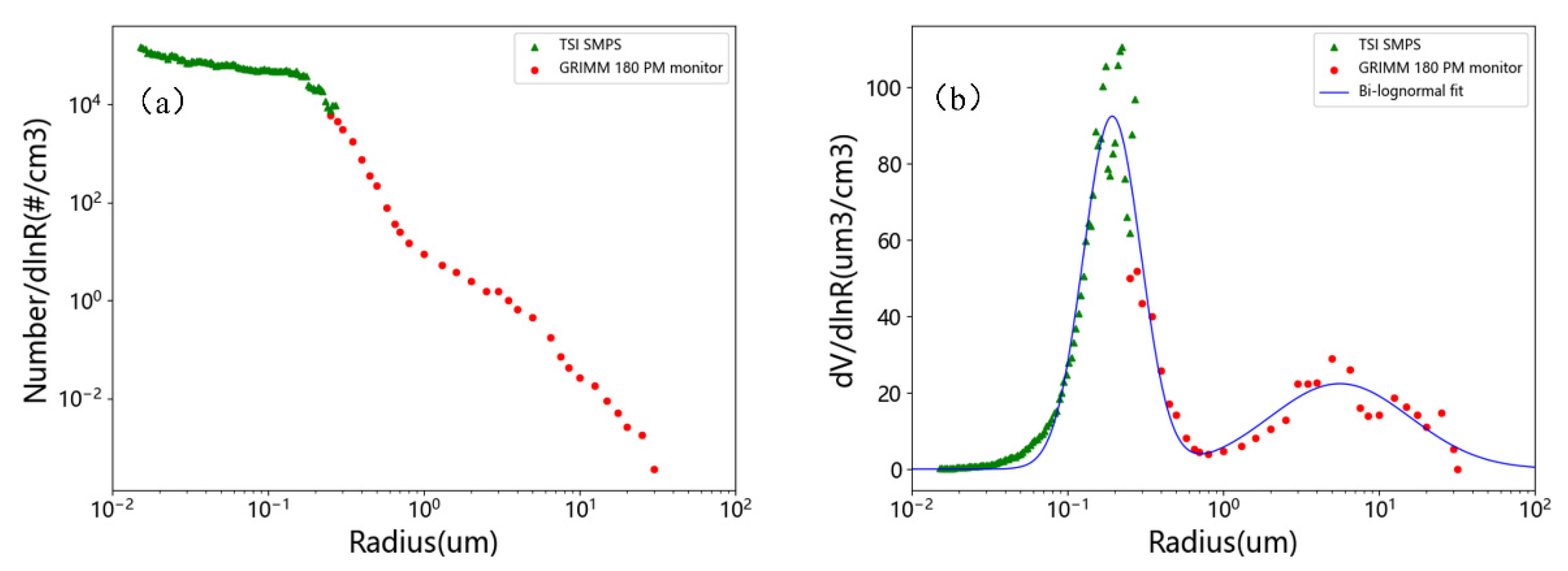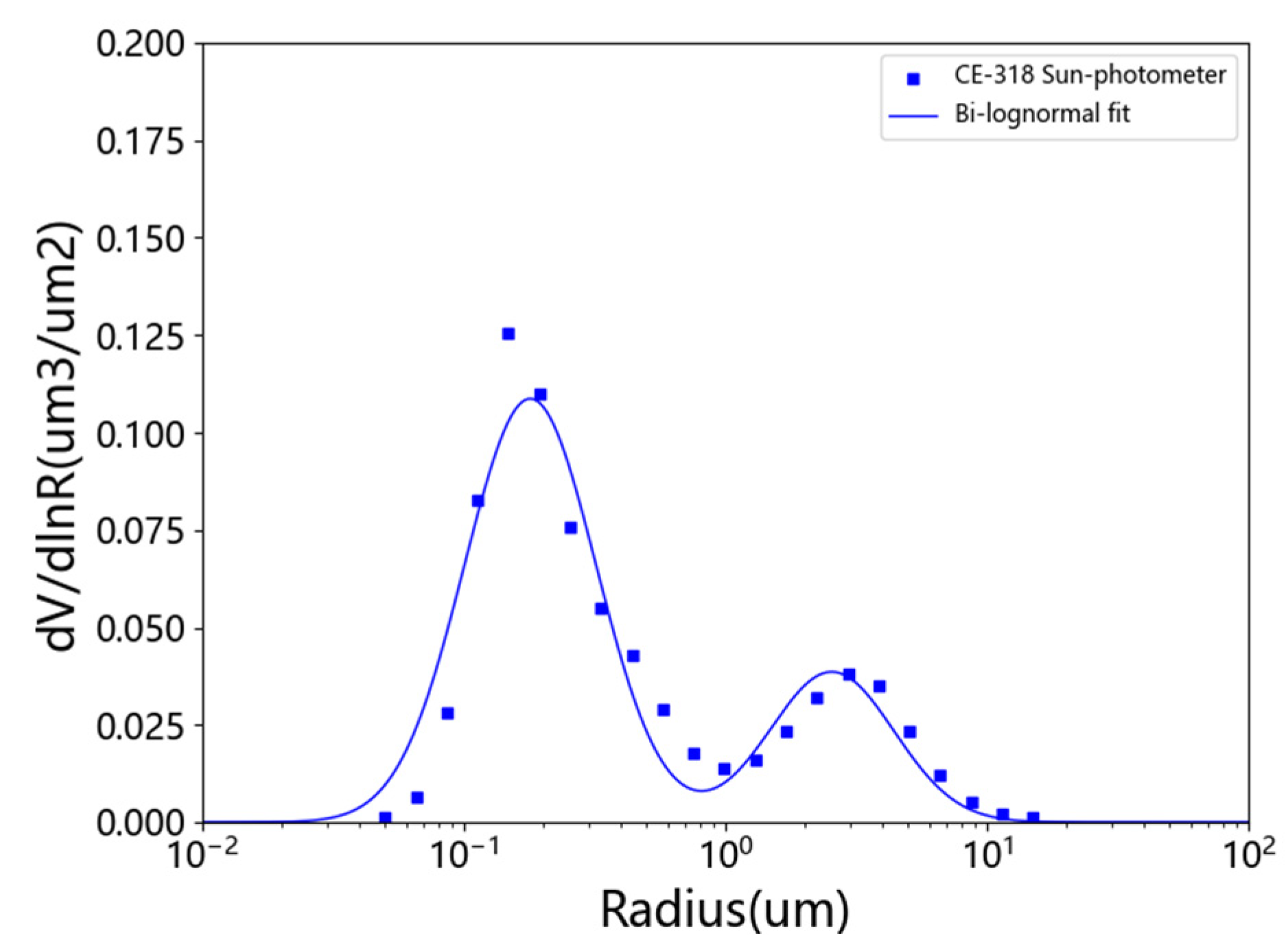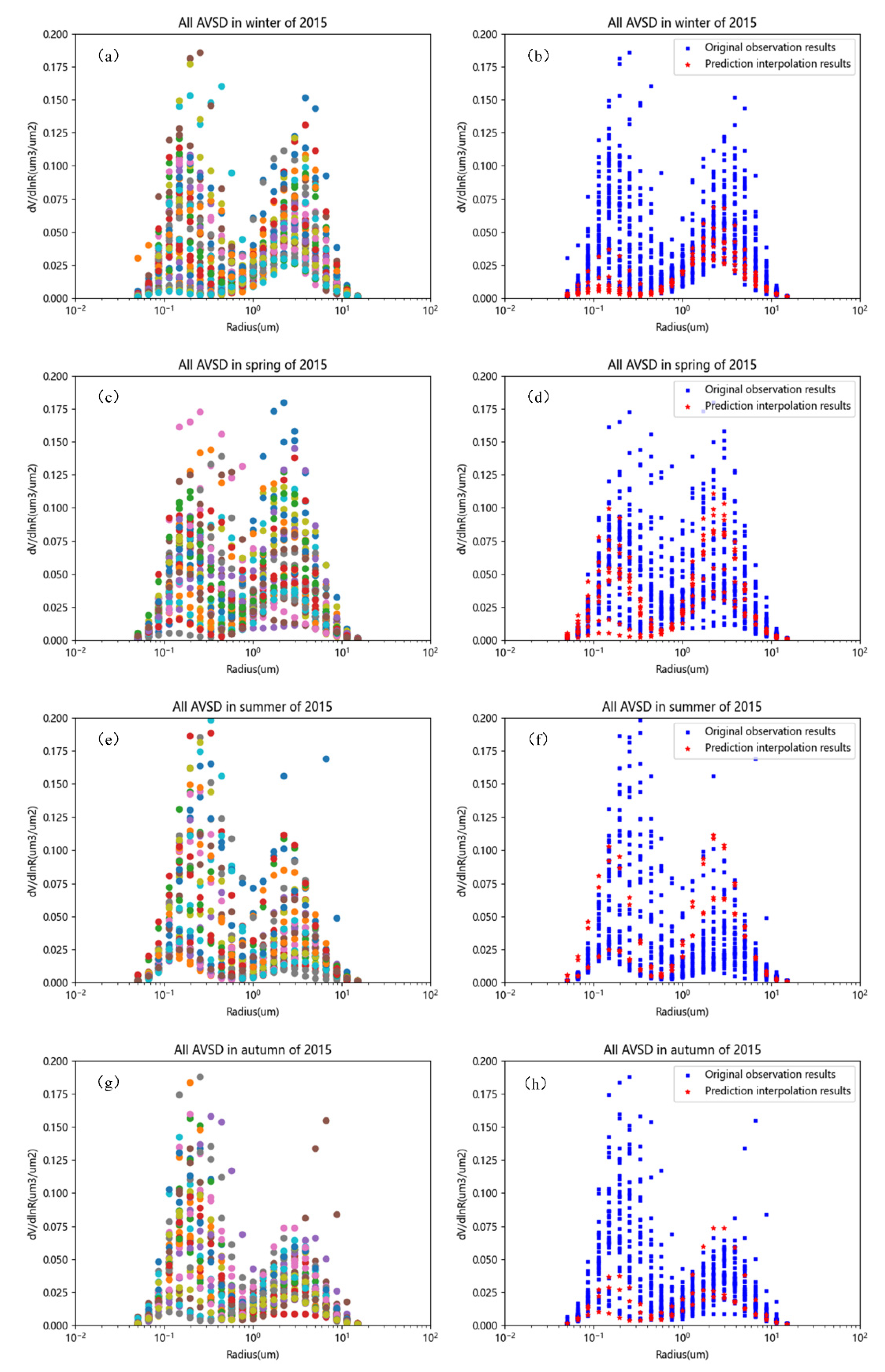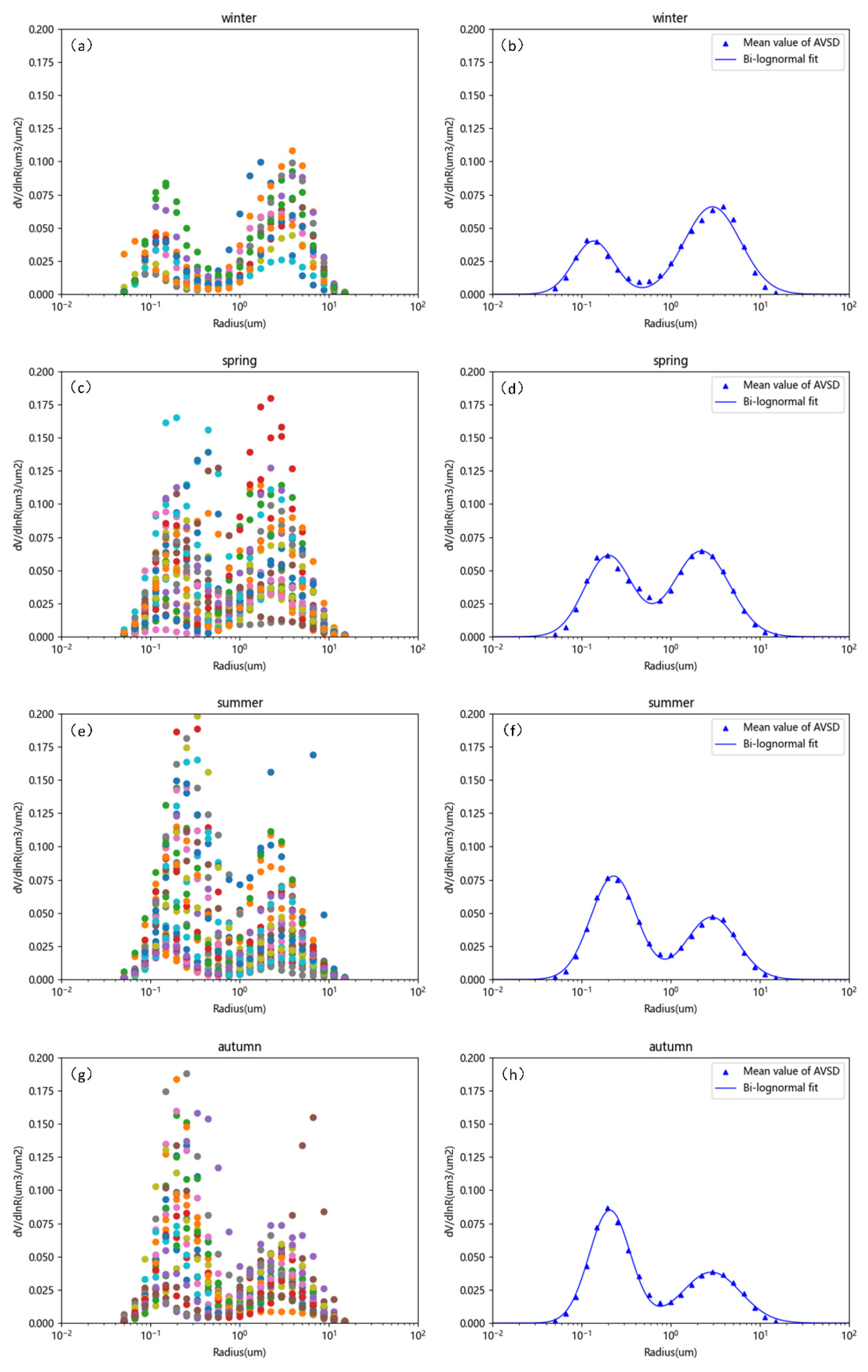Combining Sun-Photometer, PM Monitor and SMPS to Inverse the Missing Columnar AVSD and Analyze Its Characteristics in Central China
Abstract
:1. Introduction
2. Observational Instruments and Methodology
2.1. Observational Instruments
2.2. Retrieval Principle
3. Novel Algorithm Combined with Machine Learning
4. Results
5. Discussion and Conclusions
- When training the BPNN model, over-fitting may occur, and the training results of the model are also closely related to the selection of training samples, so the model needs to be adjusted according to the actual situation. Therefore, adding PM2.5 or PM10 as a constraint to obtain an inversion model more suitable for weather conditions needs to be considered in the future.
- We plan to add tethered balloon or sounding balloon data in the future to further verify the accuracy of our columnar AVSD inversion. In addition, the CE-318 sun photometer can only work during the daytime, unlike GRIMM 180 PM monitor and TSI SMPS, which also have nighttime monitoring data. But the surface AVSD is lower at night and higher during the day, so we cannot accurately predict the nighttime columnar AVSD..
- Adding more atmospheric parameters is necessary to analyze and study the principles of haze formation and dispersion more comprehensively, while the aerosol types in Wuhan are complex and require longer observation data to improve our understanding of the impact of aerosols on the atmosphere and climate.
- In bad weather conditions, we can obtain fewer data records which are not enough for long-time observation. In addition, the size range of columnar AVSD is fixed from 0.05 to 15 μm, but in fact, the size of surface AVSD obtained from our joint observations is highly variable and can range from 0.0151 to 32 μm. Therefore, exploiting a larger scale range to study the characteristics of columnar AVSD is an important topic for future research work.
Author Contributions
Funding
Institutional Review Board Statement
Informed Consent Statement
Data Availability Statement
Acknowledgments
Conflicts of Interest
References
- Ramanathan, V.; Crutzen, P.J.; Kiehl, J.; Rosenfeld, D. Aerosols, climate, and the hydrological cycle. Science 2001, 294, 2119–2124. [Google Scholar] [CrossRef] [Green Version]
- Che, H.; Xia, X.; Zhu, J.; Li, Z.; Dubovik, O.; Holben, B.; Goloub, P.; Chen, H.; Estelles, V.; Cuevas-Agulló, E. Column aerosol optical properties and aerosol radiative forcing during a serious haze-fog month over North China Plain in 2013 based on ground-based sunphotometer measurements. Atmos. Chem. Phys. 2014, 14, 2125–2138. [Google Scholar] [CrossRef] [Green Version]
- Charlson, R.J.; Schwartz, S.; Hales, J.; Cess, R.D.; Coakley, J., Jr.; Hansen, J.; Hofmann, D. Climate forcing by anthropogenic aerosols. Science 1992, 255, 423–430. [Google Scholar] [CrossRef] [PubMed]
- Baker, K.R.; Foley, K.M. A nonlinear regression model estimating single source concentrations of primary and secondarily formed PM2.5. Atmos. Environ. 2011, 45, 3758–3767. [Google Scholar] [CrossRef]
- Adam, D. Tonga volcano eruption created puzzling ripples in Earth’s atmosphere. Nature 2022, 601, 497. [Google Scholar] [CrossRef] [PubMed]
- Aubry, T.J.; Staunton-Sykes, J.; Marshall, L.R.; Haywood, J.; Abraham, N.L.; Schmidt, A. Climate change modulates the stratospheric volcanic sulfate aerosol lifecycle and radiative forcing from tropical eruptions. Nat. Commun. 2021, 12, 4708. [Google Scholar] [CrossRef]
- Huang, R.-J.; Zhang, Y.; Bozzetti, C.; Ho, K.-F.; Cao, J.-J.; Han, Y.; Daellenbach, K.R.; Slowik, J.G.; Platt, S.M.; Canonaco, F. High secondary aerosol contribution to particulate pollution during haze events in China. Nature 2014, 514, 218–222. [Google Scholar] [CrossRef] [Green Version]
- Ding, A.; Huang, X.; Nie, W.; Sun, J.; Kerminen, V.M.; Petäjä, T.; Su, H.; Cheng, Y.; Yang, X.Q.; Wang, M. Enhanced haze pollution by black carbon in megacities in China. Geophys. Res. Lett. 2016, 43, 2873–2879. [Google Scholar] [CrossRef]
- World Health Organization. Health Aspects of Air Pollution: Results from the WHO Project “Systematic Review of Health Aspects of Air Pollution in Europe”; WHO: Geneva, Switzerland, 2004. [Google Scholar]
- Chameides, W.L.; Yu, H.; Liu, S.; Bergin, M.; Zhou, X.; Mearns, L.; Wang, G.; Kiang, C.; Saylor, R.; Luo, C. Case study of the effects of atmospheric aerosols and regional haze on agriculture: An opportunity to enhance crop yields in China through emission controls? Proc. Natl. Acad. Sci. USA 1999, 96, 13626–13633. [Google Scholar] [CrossRef] [Green Version]
- Li, Z.; Xia, X.; Cribb, M.; Mi, W.; Holben, B.; Wang, P.; Chen, H.; Tsay, S.C.; Eck, T.; Zhao, F. Aerosol optical properties and their radiative effects in northern China. J. Geophys. Res. Atmos. 2007, 112. [Google Scholar] [CrossRef]
- Chen, J.; Xin, J.; An, J.; Wang, Y.; Liu, Z.; Chao, N.; Meng, Z. Observation of aerosol optical properties and particulate pollution at background station in the Pearl River Delta region. Atmos. Res. 2014, 143, 216–227. [Google Scholar] [CrossRef]
- Xia, X.; Li, Z.; Holben, B.; Wang, P.; Eck, T.; Chen, H.; Cribb, M.; Zhao, Y. Aerosol optical properties and radiative effects in the Yangtze Delta region of China. J. Geophys. Res. Atmos. 2007, 112. [Google Scholar] [CrossRef]
- Wang, H.-J.; Chen, H.-P. Understanding the recent trend of haze pollution in eastern China: Roles of climate change. Atmos. Chem. Phys. 2016, 16, 4205–4211. [Google Scholar] [CrossRef] [Green Version]
- Liu, X.; Li, J.; Qu, Y.; Han, T.; Hou, L.; Gu, J.; Chen, C.; Yang, Y.; Liu, X.; Yang, T. Formation and evolution mechanism of regional haze: A case study in the megacity Beijing, China. Atmos. Chem. Phys. 2013, 13, 4501–4514. [Google Scholar] [CrossRef] [Green Version]
- Ma, Y.; Gong, W.; Wang, L.; Zhang, M.; Chen, Z.; Li, J.; Yang, J. Inversion of the haze aerosol sky columnar AVSD in central China by combining multiple ground observation equipment. Opt. Express 2016, 24, 8170–8185. [Google Scholar] [CrossRef]
- Liu, B.; Ma, X.; Ma, Y.; Li, H.; Jin, S.; Fan, R.; Gong, W. The relationship between atmospheric boundary layer and temperature inversion layer and their aerosol capture capabilities. Atmos. Res. 2022, 271, 106121. [Google Scholar] [CrossRef]
- Dubovik, O.; King, M.D. A flexible inversion algorithm for retrieval of aerosol optical properties from Sun and sky radiance measurements. J. Geophys. Res. Atmos. 2000, 105, 20673–20696. [Google Scholar] [CrossRef] [Green Version]
- King, M.D.; Byrne, D.M.; Herman, B.M.; Reagan, J.A. Aerosol size distributions obtained by inversions of spectral optical depth measurements. J. Atmos. Sci. 1978, 35, 2153–2167. [Google Scholar] [CrossRef]
- Böckmann, C. Hybrid regularization method for the ill-posed inversion of multiwavelength lidar data in the retrieval of aerosol size distributions. Appl. Opt. 2001, 40, 1329–1342. [Google Scholar] [CrossRef]
- Nakajima, T.; Tonna, G.; Rao, R.; Boi, P.; Kaufman, Y.; Holben, B. Use of sky brightness measurements from ground for remote sensing of particulate polydispersions. Appl. Opt. 1996, 35, 2672–2686. [Google Scholar] [CrossRef]
- Chen, X.; Wang, Z.; Li, J.; Yang, W.; Chen, H.; Wang, Z.; Hao, J.; Ge, B.; Wang, D.; Huang, H. Simulation on different response characteristics of aerosol particle number concentration and mass concentration to emission changes over mainland China. Sci. Total Environ. 2018, 643, 692–703. [Google Scholar] [CrossRef] [PubMed]
- Liu, S.; Xing, J.; Zhao, B.; Wang, J.; Wang, S.; Zhang, X.; Ding, A. Understanding of aerosol–climate interactions in China: Aerosol impacts on solar radiation, temperature, cloud, and precipitation and its changes under future climate and emission scenarios. Curr. Pollut. Rep. 2019, 5, 36–51. [Google Scholar] [CrossRef]
- Goloub, P.; Li, Z.; Dubovik, O.; Blarel, L.; Podvin, T.; Jankowiak, I.; Lecoq, R.; Deroo, C.; Chatenet, B.; Morel, J. PHOTONS/AERONET Sunphotometer Network Overview: Description, Activities, Results. Available online: https://doi.org/10.1117/12.783171 (accessed on 1 June 2022).
- Cheng, J.; Masser, I. Urban growth pattern modeling: A case study of Wuhan city, PR China. Landsc. Urban Plan. 2003, 62, 199–217. [Google Scholar] [CrossRef]
- Dubovik, O.; Smirnov, A.; Holben, B.; King, M.; Kaufman, Y.; Eck, T.; Slutsker, I. Accuracy assessments of aerosol optical properties retrieved from Aerosol Robotic Network (AERONET) Sun and sky radiance measurements. J. Geophys. Res. Atmos. 2000, 105, 9791–9806. [Google Scholar] [CrossRef] [Green Version]
- Masoumi, A.; Khalesifard, H.; Bayat, A.; Moradhaseli, R. Retrieval of aerosol optical and physical properties from ground-based measurements for Zanjan, a city in Northwest Iran. Atmos. Res. 2013, 120, 343–355. [Google Scholar] [CrossRef]
- Che, H.; Zhang, X.; Chen, H.; Damiri, B.; Goloub, P.; Li, Z.; Zhang, X.; Wei, Y.; Zhou, H.; Dong, F. Instrument calibration and aerosol optical depth validation of the China Aerosol Remote Sensing Network. J. Geophys. Res. Atmos. 2009, 114. [Google Scholar] [CrossRef]
- Dubovik, O.; Holben, B.; Eck, T.F.; Smirnov, A.; Kaufman, Y.J.; King, M.D.; Tanré, D.; Slutsker, I. Variability of absorption and optical properties of key aerosol types observed in worldwide locations. J. Atmos. Sci. 2002, 59, 590–608. [Google Scholar] [CrossRef]
- Che, H.; Xia, X.; Zhu, J.; Wang, H.; Wang, Y.; Sun, J.; Zhang, X.; Shi, G. Aerosol optical properties under the condition of heavy haze over an urban site of Beijing, China. Environ. Sci. Pollut. Res. 2015, 22, 1043–1053. [Google Scholar] [CrossRef]
- Deng, X.; Li, F.; Li, Y.; Li, J.; Huang, H.; Liu, X. Vertical distribution characteristics of PM in the surface layer of Guangzhou. Particuology 2015, 20, 3–9. [Google Scholar] [CrossRef]
- Grimm, H.; Eatough, D.J. Aerosol measurement: The use of optical light scattering for the determination of particulate size distribution, and particulate mass, including the semi-volatile fraction. J. Air Waste Manag. Assoc. 2009, 59, 101–107. [Google Scholar] [CrossRef]
- Hogrefe, O.; Lala, G.G.; Frank, B.P.; Schwab, J.J.; Demerjian, K.L. Field evaluation of a TSI model 3034 scanning mobility particle sizer in New York City: Winter 2004 intensive campaign. Aerosol Sci. Technol. 2006, 40, 753–762. [Google Scholar] [CrossRef] [Green Version]
- Huang, J.; Wang, T.; Wang, W.; Li, Z.; Yan, H. Climate effects of dust aerosols over East Asian arid and semiarid regions. J. Geophys. Res. Atmos. 2014, 119, 11398–11416. [Google Scholar] [CrossRef]
- Remer, L.A.; Kaufman, Y.J. Dynamic aerosol model: Urban/industrial aerosol. J. Geophys. Res. Atmos. 1998, 103, 13859–13871. [Google Scholar] [CrossRef] [Green Version]
- Wang, Z. Optimizing BP Neural Network Prediction Model based on WOA. Int. Core J. Eng. 2021, 7, 342–348. [Google Scholar]
- Hecht-Nielsen, R. Theory of the backpropagation neural network. In Neural Networks for Perception; Elsevier: Amsterdam, The Netherlands, 1992; pp. 65–93. [Google Scholar]
- Amari, S.I. Backpropagation and stochastic gradient descent method. Neurocomputing 1993, 5, 185–196. [Google Scholar] [CrossRef]
- You, M. Addition of PM2.5 into the national ambient air quality standards of China and the contribution to air pollution control: The case study of Wuhan, China. Sci. World J. 2014, 2014, 768405. [Google Scholar] [CrossRef] [PubMed] [Green Version]
- Gong, W.; Zhang, S.; Ma, Y. Aerosol optical properties and determination of aerosol size distribution in Wuhan, China. Atmosphere 2014, 5, 81–91. [Google Scholar] [CrossRef] [Green Version]
- Ma, Y.; Zhang, M.; Jin, S.; Gong, W.; Chen, N.; Chen, Z.; Jin, Y.; Shi, Y. Long-Term Investigation of Aerosol Optical and Radiative Characteristics in a Typical Megacity of Central China during Winter Haze Periods. J. Geophys. Res. Atmos. 2019, 124, 12093–12106. [Google Scholar] [CrossRef]
- Jin, S.; Ma, Y.; Zhang, M.; Gong, W.; Lei, L.; Ma, X. Comparation of aerosol optical properties and associated radiative effects of air pollution events between summer and winter: A case study in January and July 2014 over Wuhan, Central China. Atmos. Environ. 2019, 218, 117004. [Google Scholar] [CrossRef]
- Liu, H.; Shao, J.; Jiang, W.; Liu, X. Numerical Modeling of Droplet Aerosol Coagulation, Condensation/Evaporation and Deposition Processes. Atmosphere 2022, 13, 326. [Google Scholar] [CrossRef]








| Instruments | December 2014 | January 2015 | February 2015 |
|---|---|---|---|
| Combining sun photometer, PM monitor and SMPS | 12.6–8; 12.12–13; 12.16–17; 12.19–24; 12.28–31; 17 days | 1.1; 1.3–4; 1.11; 1.14–18; 1.21–22; 11 days | 2.4–6; 2.8–9; 2.11–12; 7 days |
| Inversion Result and PM2.5 Records | ||||||
|---|---|---|---|---|---|---|
| Date | 6 December 2014 | 7 December 2014 | 8 December 2014 | 12 December 2014 | 13 December 2014 | 16 December 2014 |
| r | 0.9881 | 0.9697 | 0.9776 | 0.9732 | 0.9792 | 0.9896 |
| PM2.5 | 66 | 62 | 74 | 77 | 72 | 26 |
| Date | 17 December 2014 | 20 December 2014 | 21 December 2014 | 22 December 2014 | 24 December 2014 | 28 December 2014 |
| r | 0.9309 | 0.9979 | 0.9896 | 0.9954 | 0.9914 | 0.9849 |
| PM2.5 | 47 | 92 | 71 | 85 | 127 | 112 |
| Date | 28 December 2014 | 31 December 2014 | 1 January 2015 | 3 January 2015 | 4 January 2015 | 11 January 2015 |
| r | 0.9813 | 0.9926 | 0.9745 | 0.9791 | 0.9938 | 0.9878 |
| PM2.5 | 97 | 113 | 51 | 112 | 128 | 169 |
| Date | 16 January 2015 | 17 January 2015 | 18 January 2015 | 21 January 2015 | 22 January 2015 | 4 February 2015 |
| r | 0.9714 | 0.9898 | 0.9931 | 0.9774 | 0.9943 | 0.9946 |
| PM2.5 | 124 | 135 | 113 | 106 | 108 | 180 |
| Date | 5 February 2015 | 6 February 2015 | 8 February 2015 | 9 February 2015 | 11 February 2015 | 12 February 2015 |
| r | 0.9776 | 0.9571 | 0.9926 | 0.9603 | 0.9753 | 0.9745 |
| PM2.5 | 182 | 118 | 173 | 57 | 137 | 159 |
| Winter | Spring | Summer | Autumn | |
|---|---|---|---|---|
| date | 30 days | 35 days | 11 days | 28 days |
| r | 0.967 | 0.968 | 0.969 | 0.972 |
| RMSE | 0.008 | 0.010 | 0.013 | 0.007 |
Publisher’s Note: MDPI stays neutral with regard to jurisdictional claims in published maps and institutional affiliations. |
© 2022 by the authors. Licensee MDPI, Basel, Switzerland. This article is an open access article distributed under the terms and conditions of the Creative Commons Attribution (CC BY) license (https://creativecommons.org/licenses/by/4.0/).
Share and Cite
Miao, A.; Jin, S.; Ma, Y.; Liu, B.; Jiang, N.; He, W.; Qian, X.; Zheng, Y. Combining Sun-Photometer, PM Monitor and SMPS to Inverse the Missing Columnar AVSD and Analyze Its Characteristics in Central China. Atmosphere 2022, 13, 915. https://doi.org/10.3390/atmos13060915
Miao A, Jin S, Ma Y, Liu B, Jiang N, He W, Qian X, Zheng Y. Combining Sun-Photometer, PM Monitor and SMPS to Inverse the Missing Columnar AVSD and Analyze Its Characteristics in Central China. Atmosphere. 2022; 13(6):915. https://doi.org/10.3390/atmos13060915
Chicago/Turabian StyleMiao, Ao, Shikuan Jin, Yingying Ma, Boming Liu, Nan Jiang, Wenzhuo He, Xiaokun Qian, and Yifan Zheng. 2022. "Combining Sun-Photometer, PM Monitor and SMPS to Inverse the Missing Columnar AVSD and Analyze Its Characteristics in Central China" Atmosphere 13, no. 6: 915. https://doi.org/10.3390/atmos13060915
APA StyleMiao, A., Jin, S., Ma, Y., Liu, B., Jiang, N., He, W., Qian, X., & Zheng, Y. (2022). Combining Sun-Photometer, PM Monitor and SMPS to Inverse the Missing Columnar AVSD and Analyze Its Characteristics in Central China. Atmosphere, 13(6), 915. https://doi.org/10.3390/atmos13060915








